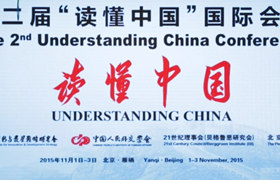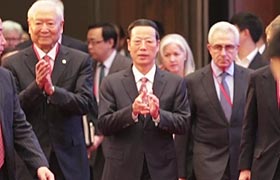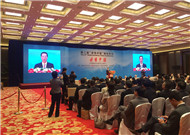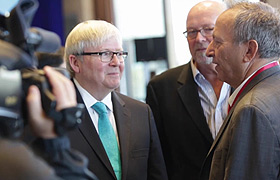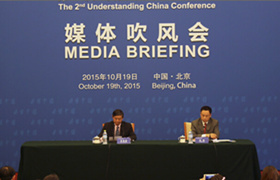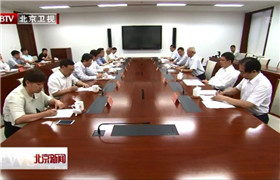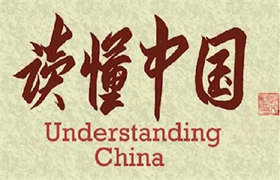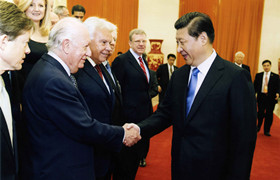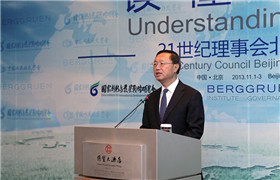- HOME--> Chairman
-
Great Changes • New Awakening • Duality
China’s Basic Development Trends in the Second Decade of the 21st Century Viewed from the Historical Context of Economic GlobalizationSource:
Zheng Bijian
Respected Chairman Zedillo,
Ladies and gentlemen, friends,
To echo the theme of our conference today, Understanding China, I’d like to speak on China’s Basic Development Trends in the Second Decade of the 21st Century Viewed from the Historical Context of Economic Globalization.I. My own thinking, consistently over the years, can be summarized into six Chinese characters, or two English phrases, “great changes and new awakening”. To be more specific, it is about great changes and new awakening in China, which is centered on China’s peaceful rise; and it is also about great changes and new awakening in the world, with peace and development as its theme. This is a great process unprecedented in the history of modern China and the world. This process started in China with the third plenum of the 11th CPC Congress in 1978 and in the world with the end of the Vietnam War in the 1970s. In less than 40 years since then, enormous changes have taken place in both China and the world. We expect this will continue and maybe the truly revolutionary changes have yet to come.
II. Please allow me to elaborate this idea by going back into history. I will explain the history of China in the context of three rounds of economic globalization in the modern period.
I will start with the two historic pursuits held by the Chinese since the Opium War in mid 19th century. These two pursuits are to gain national independence and liberation and to achieve national strength and common prosperity for our people. In short, one is about the survival of China as an independent country and the other is about rejuvenating and developing the country.Because the Chinese nation has suffered tremendously in the modern period, these two pursuits become the greatest test put before the whole nation, including the different classes, political parties and their leaders, and have also become the greatest motivation and the highest goal for the struggle of succeeding generations of Chinese since the Opium War. In 1950s, to be more specific, in 1956, Chairman Mao said that if China could not build itself into a great socialist country, it would be eliminated from this planet. Today, maybe it is fair to say that if we cannot achieve industrialization, modernization and the great renaissance of the Chinese civilization in the first half of the 21st century, sooner or later we will face the danger of being eliminated from the face of the earth. Therefore the Chinese dream today finds its logical root and historical starting point in the profound ideas of survival and development coming from a period of internal crises and foreign aggression since the beginning of modern Chinese history.
In the 173 years since the Opium War, both China and the world have experienced great changes, and the changes are closely linked together. What is the best way to describe these changes in the historical context? I believe the answer is very simple: three rounds of economic globalization in the world and three major turning points in the destiny of the Chinese nation.
Generally speaking, the first round of economic globalization started around 1750 when the illusion of a splendid “Celestial Empire” blinded Emperor Qianlong to the fact that China was quietly slipping into decline. In the same year, industrial revolution began in England. By 1840, the British had built a domestic railway network, marking the completion of industrialization in their country. In the same year, the British launched theOpium War against China, reducing it into a semi-colonial country. The year 1840 was important to both China and the UK for different reasons. For the UK, it was a hallmark of prosperity, and for China, it was the beginning of foreign domination and humiliation. Since then, the Chinese dream of survival and development had begun. And a series of old democratic revolutions occurred across the countryuntil the monarchy was overthrown and a republic was founded under the leadership of Sun Yat-sen. It was Dr. Sun Yat-sen who first called on the nation to “rejuvenate China” and pioneered modern national-democratic revolution in its real sense. But the revolution of 1911 failed to change the nature of the old Chinese society and the country continued on its track of decline. By and large, the Chinese didn’t seize the opportunity in the first round of economic globalization of over 100 years from mid 18th century to the end of the 19th century. On the contrary, we hit the rock bottom and became the biggest victim of economic globalization and capitalist colonialism.
That was the fate of China in the first round of economic globalization.
What about the second round of economic globalization? At the end of the 19th century and the beginning of the 20th century, capitalist countries in the west entered the stage of financial capitalism (imperialism). As the newly emerged imperialist powers sought to re-divide the world, two world wars broke out and as a result, the second round of economic globalization came to a halt and the trend was reversed. At the same time, the world wars gave rise to revolutions. Two world wars led to two great revolutions at the weakest links of capitalist imperialism, one being the October Revolution in Russia leading to the founding of USSR and the other the great revolution of the Chinese people led by Chairman Mao and the CPC leading to the founding of the People’s Republic of China. Different from in the first round of economic globalization, the Chinese seized the opportunity of the disruption in this round to start a revolution that led to national independence and liberation in the real sense and made it possible to achieve the historical pursuit and historical progress sought by the Chinese since modern times.
That was the fate of China in the second round of economic globalization.
What about the third round of economic globalization? After WWII there was a transitional period when the two superpowers capable of waging world wars met severe setbacks in their global strategy, including American’s failure in the Vietnam War and Soviet Union’s failure in the Afghanistan War. Then the world gradually moved to a new historical period of peace and development from mid 1970s to mid 1980s, marking the beginning of the new technological revolution and the third round of economic globalization. This time, the Soviet Communist Party and the Soviet Union collapsed from their pursuit of hegemony and a rigid development model. The Chinese, on the other hand, seized new opportunities to accelerate our development, just as we did in the second round of globalization to accomplish revolutions. Since the third plenum of the 11th CPC Congress, we’ve been embarking on a path of independently building socialism with Chinese characteristics in connection with and not detached from the process of economic globalization, focusing on economic development and reform and opening up. Viewed from the perspective of overall domestic and international situations, this path is a path of peaceful rise or peaceful development.
That is the fate of China in the third round of economic globalization, and we’ve been following this path for thirty four years now.
III. In the second decade of the 21st century, with new historical conditions, the Chinese people will, through our renewed effort, develope new vigor and enthusiasm and achieve an essentially new awakening.
First, we are determined to keep our door open to the world. As China develops, it will open its door wider and develop more common interest with the rest of the world. The recently established Shanghai Free Trade Zone is an important sign of China opening further to the world.
Secondly, China will continue to focus on our fundamental task of liberating and developing productive forces, do our best to restructure the economy, improve the quality of economic growth, vigorously develop science, technology and education, unleash the vitality of the whole society for innovation and entrepreneurship, and build capacity and vitality to withstand risks.
Thirdly, we will deepen reform in a comprehensive manner, fully tap the role of market as the primary mechanism to allocate resources, further address the relationship between government and market, build a unified national market system and integrate the domestic market with the international market.
Fourthly, China will adhere to the “five-in-one” strategy to integrate economic, political, social, cultural and ecological development and improve social governance to make our society more dynamic and orderly and to ensure that our people enjoy more benefits of development.
Fifthly, China must adhere to the development path of peaceful rise. This is not diplomatic rhetoric but a firm policy that points to the direction of historical development. The word “peace” is to counter the China Threat rhetoric and the word “rise” is to prove that the China Collapse assertions are entirely groundless. It is not only China’s strategic choice but also China’s new awakening to break away from the old logic of “power leading to hegemony”.
These sets of new awakening are key to the solution of tough problems in China, but we have kept our calm and reason to understand that there is still a long way to go in this round of great changes in order to achieve our goal of modernization by the middle of the 21st century and we are prepared for that. Here I would like to emphasize two concepts. One is “the primary stage of socialism” and the other is “the largest developing country”. These concepts reflect our understanding of the position of China today, which means that we are far from being a developed country, especially in terms of soft power such as institution and culture, etc.
IV. At the turn of the century, unprecedented changes and awakening occurred in the world. The conflicts and confrontation between the Eastern and Western blocs came to an end; economic globalization swept across the world and a global market system began to take shape. In the 21st century, especially since the 2008/2009 international financial crisis, the process of great changes and new awakening has displayed some new characteristics, with the emergence of a number of new elements unknown to the world before. Globalization and global governance have entered a new stage. As emerging countries are rising peacefully together, they form a new force to balance with traditional western powers. Also, global economic governance mechanisms represented by G20 have come into existence.
As I said at the beginning, in less than 40 years, new great changes have taken place in both China and the world and we will continue to see enormous changes in the future.
Since the theme of our conference is “Understanding China”, and in the interest of time, I will not spend too much time on the great changes and new awakening of the world.
V. Of course, the world is complex and many different factors are at play. Things often exhibit a complex web of duality. When we observe the major powers today, we can see that on the one hand, peace and development are the mainstream and the interests of different countries are increasingly interdependent. On the other hand, hegemony and power politics still characterize the behaviors of some big countries. Right now a new type of great power relationship, still young and fragile, and the traditional great power relationship, entrenched and stubborn, exist side by side. Against such a background, major countries have only three options. The first is to continue with the cold war thinking and to engage in various forms of cold war; the second is to engage in local hot wars as another world war is not possible; and the third option is to break a new path and develop converging interests and communities of interests for common development. We know through our experience what the first two options would bring to the people. We are opposed to them but we are not terrified. The Chinese are in favor of the third option, which is to steadfastly pursue the development path of peaceful rise on the basis of solid domestic growth (including national defense) in the context of economic globalization and to enlarge convergence of interests and build communities of interests with all countries and regions, first of all with surrounding countries and regions.
In a word, the process of great changes and new awakening in the world in the second decade of the 21st century will be full of complex developments with a dual nature. Maybe they are far more complicated and profound than we can expect based on our experience or routine practice. But still, we are convinced that great changes and new awakening represent the mainstream and the general trend, and they will continue to move forward inexorably.
Here I would like to repeat what I said at the beginning: the truly revolutionary changes and new awakening in both China and the world have yet to come.
Having said that, maybe now I can add the word “duality” to “great changes and new awakening” and use these three phrases, or nine Chinese characters, as the summary of all my thinking.
VI. Last but not the least, I would like to quote an old Chinese saying “the best friendship is the friendship of the heart and the mind” to describe the cooperative relationship between China Institute for Innovation and Development Strategy,Chinese People’s Institute of Foreign Affairsand the 21st Century Council. We haven’t known each other long, but we have developed several points of consensus, the most important of which is that we all believe “communities of interest” developed on the basis of expanding “convergence of interests” among various countries reflect the trends of our times and represent the central feature of international relationship in the 21st century. We are also convinced that China will not deviate from its strategic choice of pursuing a development path of peaceful rise, which is one of the most important drivers for peaceful development in the world. With these two points of consensus, we can form a clear picture of the relationship between China and the rest of the world. Dear friends, our hearts are connected. This makes sure that the 21st Century Council Conference in Beijing will be a great success!
Thank you!
-
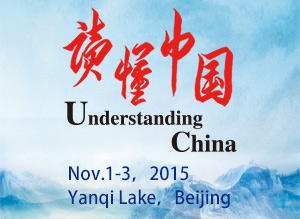
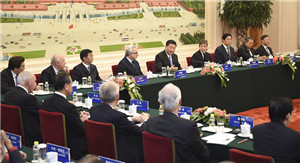
The 2nd "Understanding China" ConferenceOn November 1~3, 2015, the 2nd “Understanding China” Conference was held in Beijing Yanqi Lake International Conference Center. Zhang Gaoli, Vice Premier of the State Council, attended the opening ceremony.
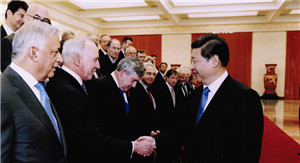
The 1st "Understanding China" ConferenceOn November 1~3, 2013, the 1st “Understanding China” Conference was held in Beijing, which was cosponsored by China Institute for Innovation & Development Strategy (CIIDS), Chinese People’s Institute of Foreign Affairs (CPIFA), and Berggruen Institute on Governance.
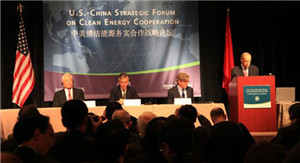
The 2nd U.S.-China Strategic Forum on Clean Energy CooperationWith the “Prospects for U.S.-China strategic cooperation in next decade” as its theme, the forum dwells on the implications of U.S.-China cooperation from the strategic perspective of coping with global challenges and maintaining world peace.
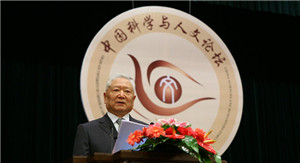
The China Sciences and Humanities ForumCo-initiated in April 2003 by renowned Chinese scientist Mr. Lu Yongxiang and influential political strategist Zhen Bijian, China Sciences and Humanities Forum was jointly hosted by Graduate University of Chinese Academy of Sciences (GUCAS) and the Higher Education Press.

